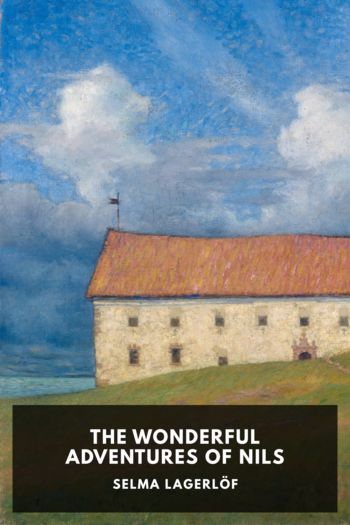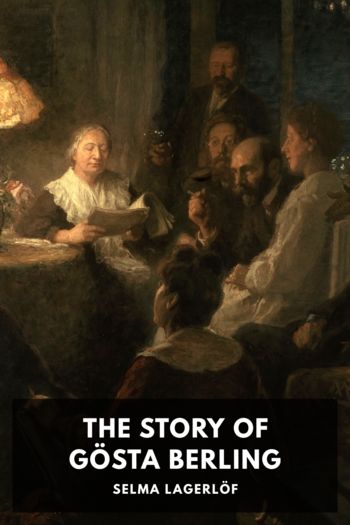The Wonderful Adventures of Nils by Selma Lagerlöf (i can read book club TXT) 📕

Description
In The Wonderful Adventures of Nils, Selma Lagerlöf tells the story of Nils Holgersson, a young boy who is transformed into an elf after a set of misdeeds. Escaping with his family’s farm goose he joins up with a flock of wild geese and travels with them across Sweden as they return to their annual nesting grounds in Lapland.
The story was originally written as a commission for the Swedish National Teachers’ Association to write a geography book for children and has become a firm favourite in the country. It’s been adapted for screen many times, translated into over 30 languages and, until recently, was the artwork on the 20 krona banknote.
Although originally published in English in two volumes—the second starting at “The Story of Karr and Grayskin”—here they are presented as a single combined story.
Read free book «The Wonderful Adventures of Nils by Selma Lagerlöf (i can read book club TXT) 📕» - read online or download for free at americanlibrarybooks.com
- Author: Selma Lagerlöf
Read book online «The Wonderful Adventures of Nils by Selma Lagerlöf (i can read book club TXT) 📕». Author - Selma Lagerlöf
Just then he saw the wooden man bend down to him and stretch forth his big, broad hand. It was impossible to believe anything but good of him; and with one jump, the boy stood in his hand. The wooden man lifted him to his hat—and stuck him under it.
The boy was just hidden, and the wooden man had just gotten his arm in its right place again, when the bronze man stopped in front of him and banged the stick on the ground, so that the wooden man shook on his pedestal. Thereupon the bronze man said in a strong and resonant voice: “Who might this one be?”
The wooden man’s arm went up, so that it creaked in the old woodwork, and he touched his hat brim as he replied: “Rosenbom, by Your Majesty’s leave. Once upon a time boatswain on the man-of-war, Dristigheten; after completed service, sexton at the Admiral’s church—and, lately, carved in wood and exhibited in the churchyard as a poor-box.”
The boy gave a start when he heard that the wooden man said “Your Majesty.” For now, when he thought about it, he knew that the statue on the square represented the one who had founded the city. It was probably no less an one than Charles the Eleventh himself, whom he had encountered.
“He gives a good account of himself,” said the bronze man. “Can he also tell me if he has seen a little brat who runs around in the city tonight? He’s an impudent rascal, if I get hold of him, I’ll teach him manners!” With that, he again pounded on the ground with his stick, and looked fearfully angry.
“By Your Majesty’s leave, I have seen him,” said the wooden man; and the boy was so scared that he commenced to shake where he sat under the hat and looked at the bronze man through a crack in the wood. But he calmed down when the wooden man continued: “Your Majesty is on the wrong track. That youngster certainly intended to run into the shipyard, and conceal himself there.”
“Does he say so, Rosenbom? Well then, don’t stand still on the pedestal any longer but come with me and help me find him. Four eyes are better than two, Rosenbom.”
But the wooden man answered in a doleful voice: “I would most humbly beg to be permitted to stay where I am. I look well and sleek because of the paint, but I’m old and mouldy, and cannot stand moving about.”
The bronze man was not one of those who liked to be contradicted. “What sort of notions are these? Come along, Rosenbom!” Then he raised his stick and gave the other one a resounding whack on the shoulder. “Does Rosenbom not see that he holds together?”
With that they broke off and walked forward on the streets of Karlskrona—large and mighty—until they came to a high gate, which led to the shipyard. Just outside and on guard walked one of the navy’s jack-tars, but the bronze man strutted past him and kicked the gate open without the jack-tar’s pretending to notice it.
As soon as they had gotten into the shipyard, they saw before them a wide, expansive harbor separated by pile-bridges. In the different harbour basins, lay the warships, which looked bigger, and more awe-inspiring close to, like this, than lately, when the boy had seen them from up above. “Then it wasn’t so crazy after all, to imagine that they were sea-trolls,” thought he.
“Where does Rosenbom think it most advisable for us to begin the search?” said the bronze man.
“Such an one as he could most easily conceal himself in the hall of models,” replied the wooden man.
On a narrow land-strip which stretched to the right from the gate, all along the harbour, lay ancient structures. The bronze man walked over to a building with low walls, small windows, and a conspicuous roof. He pounded on the door with his stick until it burst open; and tramped up a pair of worn-out steps. Soon they came into a large hall, which was filled with tackled and full-rigged little ships. The boy understood without being told, that these were models for the ships which had been built for the Swedish navy.
There were ships of many different varieties. There were old men-of-war, whose sides bristled with cannon, and which had high structures fore and aft, and their masts weighed down with a network of sails and ropes. There were small island-boats with rowing-benches along the sides; there were undecked cannon sloops and richly gilded frigates, which were models of the ones the kings had used on their travels. Finally, there were also the heavy, broad armour-plated ships with towers and cannon on deck—such as are in use nowadays; and narrow, shining torpedo boats which resembled long, slender fishes.
When the boy was carried around among all this, he was awed. “Fancy that such big, splendid ships have been built here in Sweden!” he thought to himself.
He had plenty of time to see all that was to be seen in there; for when the bronze man saw the models, he forgot everything else. He examined them all, from the first to the last, and asked about them. And Rosenbom, the boatswain on the Dristigheten, told as much as he knew of the ships’ builders, and of those who had manned them; and of the fates they had met. He told them about Chapman and Puke and Trolle; of Hoagland and Svensksund—all the way along until 1809—after that he had not been there.
Both he and the bronze man had the most to say about the fine old wooden ships. The new battleships they didn’t exactly appear to understand.
“I can hear that Rosenbom doesn’t know anything





Comments (0)